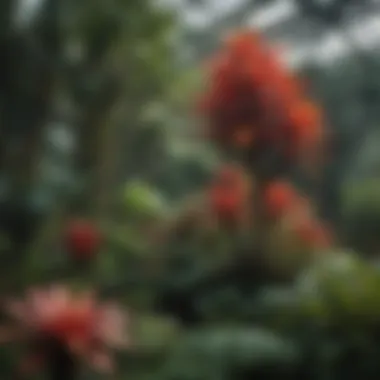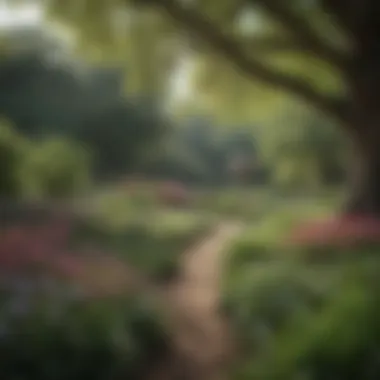Discover Kew Botanical Gardens: History and Diversity


Intro
The Kew Botanical Gardens, known formally as the Royal Botanic Gardens, Kew, stands as a monumental institution steeped in both scientific and historical significance. As one of the largest and most diverse botanical gardens in the world, Kew offers an expansive collection of plant species from every corner of the globe. The garden serves not just as a sanctuary for flora but also as a vital resource for education, research, and conservation, catering to students, researchers, educators, and professionals.
Visitors to Kew are greeted by striking landscapes and a rich tapestry of plant collections. From the iconic Palm House to the serene waterlilies of the Waterlily House, Kew is not only a place of beauty but also a living archive of plant diversity. The gardens are a testament to ongoing efforts in botanical research and preservation, which are crucial in an era where biodiversity faces unprecedented threats.
Kew's role extends beyond aesthetics; it actively engages in global initiatives aimed at understanding and conserving plant diversity. Researchers at Kew study various aspects of botany, including taxonomy, ecology, and genetics, contributing valuable insights to the scientific community. The institution is recognized worldwide for its efforts to document and analyze plant species and ecosystems.
This article will delve into the historical context, diverse collections, significant research initiatives, and educational programs that Kew offers. Through this exploration, we aim to illuminate Kew Botanical Gardens' pivotal role in promoting botanical knowledge and facilitating conservation efforts.
Historical Overview of Kew Gardens
The historical overview of Kew Gardens provides crucial context for understanding its evolution and significance as a botanical institution. This section examines the key developments that have shaped Kew, shedding light on its role in botanical research and conservation. By delving into the foundation, evolution, and recognition of Kew, readers will grasp the importance of this site not only in its local context but also globally.
Foundation and Development
Kew Gardens was founded in the 18th century, with its roots traceable to the royal estate at Kew, which was initially a private garden. In 1759, Princess Augusta, the mother of King George III, began developing the gardens as a place of both aesthetic enjoyment and scientific inquiry. The introduction of exotic plants and the establishment of glasshouses marked the beginning of its transformation into a botanical paradise.
The botanical collection grew substantially during the late 18th and early 19th centuries. This period saw contributions from influential botanists such as Joseph Banks, who expanded the garden's reach through expeditions and plant acquisitions. Enhanced by royal patronage, Kew soon emerged as a vital center for the study of plant science, influencing botanical explorations worldwide.
Evolution Through the Centuries
Over the centuries, Kew Gardens has undergone significant changes, adapting to new scientific discoveries and societal needs. The 19th century brought innovations in horticulture, and Kew became a model for botanical gardens globally. The establishment of the herbarium in 1853 and the introduction of the seed bank in 1976 further emphasized Kew's commitment to research and conservation.
As the garden matured, it expanded its focus from merely showcasing plants to actively participating in ecological and environmental research. The introduction of conservation programs in the late 20th century aligned with the global movement towards biodiversity protection. Today, Kew holds a diverse collection of over 30,000 plant species, making it a crucial repository of plant knowledge.
Recognition and UNESCO World Heritage Site
In 2003, Kew Gardens was designated a UNESCO World Heritage Site, recognizing its outstanding value to humanity. This honor highlights the garden's dual importance as a scientific and historical landmark. Kew's role in plant conservation, research, and education has broad implications, influencing policy and public awareness about environmental issues.
This recognition also underscores the necessity of preserving Kew's rich legacy for future generations. Kew's commitment to sustainability and its ongoing research initiatives ensure that it remains at the forefront of global botanical science.
"As a treasure trove of plant knowledge and biodiversity, Kew Gardens stands as a testament to human dedication towards understanding and preserving nature."
In summary, the historical overview of Kew Gardens reveals a garden that is much more than a collection of plants. It represents centuries of dedication to botanical science, as well as an evolving commitment to conservation and sustainability.
Architectural Landmarks within Kew
The architectural landmarks within Kew Gardens serve not only as aesthetic attractions but also encapsulate the historical, environmental, and scientific significance of the site. These structures contribute to the educational narrative of the gardens, fostering a deeper understanding of plant diversity and conservation. Each landmark tells a unique story, reflecting the era in which it was built, the intentions behind its design, and its role in promoting botanical knowledge.
These sites highlight the dual role of Kew as both a recreational space and a research institution. Visitors can appreciate the beauty while learning about various plant species and conservation efforts. The architectural integrity of these buildings also ensures that Kew maintains its status as a UNESCO World Heritage Site, making the preservation of these structures essential in safeguarding its legacy.
The Palm House: A Victorian Marvel
The Palm House is a significant piece of Victorian architecture. Completed in 1848, it showcases the elegance and ambition of the era's botanical aspirations. This structure is known for its intricate design and impressive size. It was one of the first glasshouses to employ a tropical design, skillfully blending glass and iron to create a suitable environment for exotic plants.
Visitors to the Palm House encounter a diverse collection of palm species, including the iconic Victorian era specimens. The microclimate within the Palm House allows for the cultivation of plants from regions such as Madagascar and Australia. Through displays and signage, visitors learn about the ecological roles these plants play and the importance of tropical ecosystems in the face of climate change.
"The architectural charm of the Palm House coupled with its biological significance gives it a timeless quality that draws both admiration and respect."
The Temperate House: Conservation and Beauty
The Temperate House stands as the largest Victorian glasshouse in the world, opened to the public in 1863. This monumental structure underwent extensive restoration, completed in 2018, addressing both its aesthetic appeal and functional needs for plant conservation.
Inside, the Temperate House houses plants from diverse climates, emphasizing biodiversity and conservation efforts. Visitors witness flora from regions such as Australia, Africa, and South America. The layout allows for easy navigation while educating visitors about unique habitats and the importance of preserving plant species that face the threat of extinction.
The architectural components combined with the living collections make it an epitome of both beauty and scientific purpose underlining Kew’s role as a leader in botanical preservation.
The Princess of Wales Conservatory: A Botanical Showcase


Opened in 1987, the Princess of Wales Conservatory represents a contemporary approach to botanical displays. Designed with ten different climate zones, it showcases a remarkable range of plant species from around the world. This variety allows for a multifaceted exploration of global plant diversity, and the conservatory serves as an educational platform about plant adaptations in various environments.
The design of the building itself enhances the viewing experience. Large glass surfaces and carefully planned layout bring natural light into various zones, simulating the native conditions of the plants. Educational signage throughout the conservatory provides insights into the ecological interactions of various species.
Diverse Collections of Plant Species
The role of diverse collections of plant species at Kew Gardens is profound. This variety not only contributes to the beauty of the gardens but also serves as a critical resource for scientific research and conservation efforts. By housing unique and varied plant life, Kew promotes understanding of botanical diversity and its significance in environmental stability.
Living Collections: A Global Perspective
Kew Gardens maintains a vast array of living collections, representing flora from around the world. Each plant species adds to a broader narrative about earth's biodiversity. These collections illustrate the ecological connections between various species and their environments.
Benefits of Living Collections:
- Provides opportunities for research on plant adaptability and resilience.
- Supports horticultural education and public awareness about global plant diversity.
- Serves as a living repository for species that may face extinction in their native habitats.
Kew's living collections are grouped based on specific habitats and climate conditions, showcasing the diversity of plant adaptations. This global perspective also aids in understanding the impact of climate change, as scientists can observe how different species respond to shifting environments.
Herbarium and Seed Bank: Global Biodiversity
Kew's herbarium and seed bank serve as crucial components for preserving biodiversity. The herbarium contains thousands of dried plant specimens, each meticulously cataloged. These specimens are invaluable for taxonomic research and serve as benchmarks for identifying plant species.
Key Aspects:
- The herbarium houses over seven million specimens, making it one of the largest in the world.
- The seed bank focuses on conserving seeds from rare and endangered species, ensuring genetic diversity is maintained for future generations.
By offering access to both the herbarium and seed bank, Kew plays a vital role in supporting researchers, conservationists, and policy makers in efforts to understand and preserve plant diversity. The resources here also assist in global initiatives aimed at combating biodiversity loss.
Rare and Endangered Plants: Conservation Efforts
Kew Gardens is dedicated to protecting rare and endangered plant species. Through targeted conservation programs, the gardens aim to restore threatened species to their natural habitats, ensuring their survival.
Conservation efforts at Kew are not only about preservation but also about education and engagement with the community.
Conservation Strategies:
- Conducting field studies to assess the status of endangered plants in their natural habitats.
- Engaging in propagation programs that reintroduce plants back into the wild.
- Collaborating with local communities to foster sustainable practices that support biodiversity.
By focusing on endangered plant species, Kew not only contributes to global biodiversity conservation but also inspires others to engage in protecting the planet's natural heritage. The gardens exemplify how botanical institutions can lead efforts in conservation and education, making a measurable impact on the future of plant diversity.
Research and Educational Importance
The importance of research and education at Kew Gardens cannot be overstated. It serves as a beacon of knowledge in the field of botany and plant science. The gardens act as a living laboratory where scientific inquiry and academic exploration thrive. Students, researchers, and educators benefit immensely from the resources and opportunities available at Kew. Not only does Kew contribute to a deeper understanding of plant biology, but it also plays a vital role in conservation efforts globally.
Scientific Research Initiatives
Kew Gardens is at the forefront of numerous scientific research initiatives. It undertakes a variety of studies focusing on plant taxonomy, ecology, and conservation. Among the key initiatives are the following:
- Plant Identification and Classification: Researchers at Kew work tirelessly to identify and classify plant species. These efforts are essential for biodiversity conservation.
- Genetic Research: The gardens contribute to genetic research aimed at understanding plant resilience and adaptation in changing climates.
- Climate Change Studies: Kew also engages in research that explores the impact of climate change on plant ecosystems. This work is critical in fostering awareness and informing conservation strategies.
The findings from these initiatives have significant implications not just for science, but for global policies on biodiversity and climate issues.
Collaborations with Academic Institutions
Kew Gardens maintains strong collaborations with various academic institutions. Partnerships with universities enhance the research capacity and outreach of Kew. These collaborations have several benefits, including:
- Exchange of Knowledge: Academics from different fields contribute their expertise, leading to innovative research ideas.
- Joint Research Projects: Collaborative projects often tackle pressing issues related to biodiversity and conservation. For instance, interdisciplinary projects can combine plant science with social sciences for a comprehensive approach.
- Internship Opportunities: Students affiliated with partner institutions can gain hands-on experience through internships at Kew, enriching their academic journey.
These collaborative endeavors foster a vibrant research atmosphere that promotes learning and discovery.


Public Programs and Workshops
Kew Gardens offers various public programs and workshops that are integral to its educational mission. These programs serve multiple objectives:
- Community Engagement: By involving the community, Kew raises awareness about plant conservation and biodiversity.
- Skill Development: Workshops provide participants with skills in gardening, taxonomy, and environmental stewardship.
- Special Events: Seasonal events allow visitors to engage directly with experts, learning about topics such as sustainable gardening practices and plant conservation efforts.
The educational programs at Kew not only inform but also inspire a new generation of botanists and conservationists.
Overall, the focus on research and education establishes Kew Gardens as a leading institution for botanical knowledge. Whether one is a student, educator, or professional, engaging with the resources and initiatives at Kew offers invaluable insights into the world of plants and their conservation.
Ecological Significance of Kew
The ecological significance of Kew Gardens extends beyond its role as a botanical collection; it is a critical hub for biodiversity and environmental conservation. Kew serves as a living laboratory, contributing to the understanding of ecosystems and the services they provide to humanity. It plays a pivotal role in the preservation of plant species, many of which are crucial for threats posed by climate change, habitat loss, and invasive species. This aspect attracts researchers and conservationists who seek insights into sustainable practices and ecological awareness. Kew’s efforts contribute to the greater goal of maintaining a resilient planet.
Biodiversity and Ecosystem Services
Kew Gardens houses a vast diversity of plant species from around the world, making it a key player in the promotion of biodiversity. This biodiversity is essential as it provides plants that are indispensable for food security, medicine, and ecosystem stability. The various species within Kew’s living collections support numerous ecosystem services such as pollination, nutrient cycling, and soil formation.
- Key Contributions of Biodiversity:
- Food Security: Many cultivated varieties originate from wild species, which are preserved at Kew.
- Medicinal Uses: Several plants known for their medicinal properties are conserved, promoting research in ethnobotany.
- Climate Regulation: Diverse ecosystems help in carbon sequestration, thus combating climate change.
By conserving plant diversity, Kew not only safeguards the genetic diversity necessary for resilient ecosystems but also enhances human well-being through the sustainable use of plants.
Climate Change Research and Impact Studies
Kew Gardens is at the forefront of research on climate change and its impact on plant species. Studies conducted at Kew focus on understanding how rising temperatures, shifting weather patterns, and increased carbon levels affect plant growth and distribution. This research is crucial for mitigating adverse effects on biodiversity and informing conservation strategies.
- Examples of Research Initiatives:
- Analysis of how temperature fluctuations impact flowering times in various species.
- Tracking shifts in plant distributions in response to climate variables.
- Developing guidelines for conservation efforts targeting vulnerable species.
These investigations provide valuable data and insights, helping to create adaptive management strategies that can be applied in various ecological contexts.
Restoration Projects and Sustainability Practices
Kew is not only focused on conservation but also actively engages in restoration projects that aim to rehabilitate degraded ecosystems. These projects often involve collaboration with local communities and other stakeholders, making them comprehensive efforts toward sustainability.
- Noteworthy Practices:
- Planting Native Species: Reintroducing indigenous plants helps restore natural habitats.
- Soil Health Improvement: Implementing practices that enhance soil biodiversity and structure.
- Education and Training Programs: Involving local communities in sustainable practices fosters environmental stewardship.
Kew's commitment to sustainability extends to its operations, which embrace eco-friendly practices in landscape management and resource usage.
"Kew's ecological initiatives not only address plant conservation but also enhance community engagement through education and participatory projects."
By underpinning efforts in restoration and sustainability, Kew Gardens embodies an integrated approach to ecology, underscoring the significance of botanical science in today’s world.
Visitor Engagement and Accessibility
Visitor engagement and accessibility are pivotal components of the experience at Kew Gardens. Importantly, the aim is not only to showcase diverse plant species but also to make the garden inclusive for all. This ensures that visitors can interact meaningfully with both the exhibits and the natural environment. Kew recognizes that maximizing visitor experience enhances public appreciation for botanical diversity and conservation efforts.
Visitor Facilities and Services
Kew Gardens provides an array of facilities aimed at enhancing visitor experience. These include well-maintained pathways and informative signage. Accessible restrooms and various seating options are available throughout the garden. Such services are crucial for visitors with mobility needs, ensuring they can enjoy the surroundings without barriers.
Additionally, there are cafes and gift shops positioned strategically to offer refreshments and souvenirs. The staff is trained to assist visitors, providing information and guiding them through the gardens. More so, guided tours are available that can offer insights into the plant collections. Visitors can also utilize audio guides to enhance their exploration.
"Accessibility is not just about physical access; it encompasses the ability to connect with the beauty of nature and knowledge that Kew provides."


Seasonal Events and Exhibitions
Kew Gardens hosts a variety of seasonal events and exhibitions that enhance visitor engagement. Throughout the year, specific themes are highlighted, showcasing different species and topics within the world of botany. These events draw attention to seasonal changes and their effects on plant life, fostering a deeper connection for visitors.
For example, the summer flower shows feature vibrant displays, while winter light trails transform the gardens into a wonderland. Educational workshops often accompany these events, making them beneficial for both casual visitors and plant enthusiasts. Such engagements encourage families to participate, enhancing community involvement with the gardens.
Educational Outreach and Community Involvement
Kew Gardens places great emphasis on educational outreach. The gardens offer programming designed to educate visitors about plant science and conservation. Workshops, lectures, and hands-on activities are tailored for different age groups, from children to adults. Schools are encouraged to utilize the space for field trips, fostering an early interest in nature and science among students.
Moreover, community involvement is supported through volunteer programs. Residents have opportunities to engage with the gardens, contributing to projects and events. This not only fosters a sense of ownership but also builds a knowledgeable community around Kew's mission. Such interactions benefit both the individuals involved and the broader objectives of plant conservation and education.
Global Influence of Kew Gardens
Kew Gardens serves as a beacon for global botanical initiatives. Its influence extends far beyond the picturesque landscape and diverse plant collections. Kew plays an essential role in international plant conservation, providing vital resources and knowledge that impact horticulture practices worldwide. The collaborative work at Kew encourages conservation and awareness, fostering a global community dedicated to preserving plant diversity.
International Plant Conservation Initiatives
Kew Gardens is a key player in various international plant conservation initiatives. Its Royal Botanic Gardens, Kew (RBG Kew) leads numerous projects aimed at protecting and restoring endangered plant species. Kew collaborates with numerous global organizations. These include the IUCN (International Union for Conservation of Nature) and Botanic Gardens Conservation International (BGCI).
The work often involves extensive field research. Kew scientists travel to diverse regions, documenting plant populations. They also ensure the implementation of best practices for conservation. Initiatives like the “Global Seed Vault” are prime examples of Kew’s commitment to preserving biodiversity. These projects aim to safeguard plant genetic material against threats such as habitat loss and climate change.
"The conservation of plant diversity is critical for sustaining food security, medicine, and the overall health of our planet."
Influence on Horticultural Practices Worldwide
The impact of Kew on horticultural practices is profound. The gardens are not only a place for research but also a source of inspiration for gardeners and horticulturists around the world. Kew encourages sustainable horticulture through education and promotion of best practices.
Kew Gardens provides practical guidance on plant care and cultivation. The Wisley Garden and various training programs offered by Kew demonstrate innovative techniques in horticulture. Knowledge shared through workshops helps individuals and organizations implement environmentally friendly practices in their localities. Kew’s influence is evident in the growing trend toward biodiversity in ornamental gardens, public parks, and private landscapes.
Kew’s Role in Policy Making on Environmental Issues
Kew Gardens plays a significant role in shaping policies related to environmental issues. Through research and collaboration with governmental and non-governmental organizations, Kew informs viewpoints and develops strategies targeting biodiversity loss.
Research conducted at Kew serves as evidence for policymakers, helping to create legislation that supports conservation. Kew’s expertise is critical in discussions surrounding climate change, habitat protection, and sustainable development. The gardens contribute valuable data to global databases. This information informs international policies and agreements aimed to address pressing environmental challenges. Kew’s involvement ensures that voices in plant conservation are emphasized in broader environmental policy discussions.
In summary, Kew Gardens stands as a vital hub for plant conservation and botanical research. Its global influence significantly shapes practices, policies, and collaborative efforts in the ongoing quest to preserve biodiversity.
Future Directions for Kew Gardens
The ongoing journey of Kew Gardens is marked by a commitment to innovation, sustainability, and advancing botanical science. As global challenges regarding biodiversity and climate change intensify, the future directions of Kew reflect a proactive stance in addressing these issues. Looking ahead, Kew is uniquely positioned to lead in research and conservation efforts. The developments presented in this section emphasize the significance of innovative strategies, technology integration, and sustainability practices.
Innovative Research Approaches
Kew Gardens is known for pioneering innovative research approaches that enhance plant conservation and understanding biodiversity. Current initiatives involve utilizing interdisciplinary methods that combine genomic studies, ecological assessments, and biogeographical analyses. Such research will not only increase knowledge about plant adaptations but also support conservation strategies. Collaborating with international organizations furthers this goal and amplifies Kew’s influence globally.
In particular, projects like the Kew's Millennium Seed Bank actively promote the sustainable management of plant genetic resources. Initiatives involving local communities and indigenous knowledge are integrated to strengthen conservation efforts.
Emerging Technologies in Plant Science
Advancements in technology play a crucial role in transforming botanical research at Kew. High-throughput sequencing, geographic information systems (GIS), and artificial intelligence are increasingly applied to plant studies. These tools allow researchers to analyze complex data sets and identify patterns in plant distribution and evolution.
For instance, the use of drone technology offers new perspectives on large botanical collections, facilitating detailed monitoring without disturbing ecosystems. Such integration of emerging technologies not only boosts research efficiency but also opens avenues for innovative solutions to persistent ecological challenges.
Sustainability Initiatives and Long-Term Goals
Sustainability remains at the heart of future goals for Kew Gardens. Efforts toward ecological restoration, along with sustainable practices in cultivation and conservation, are emphasized. Projects that address climate resilience in plant species highlight Kew's long-term vision. This approach involves understanding how plants respond to climatic stressors and applying this knowledge in conservation strategies.
Kew's commitment to reducing its carbon footprint aligns with global sustainability goals. Also, partnerships with local communities promote environmental stewardship and awareness about biodiversity. To support these initiatives, Kew actively engages in education programs that emphasize the significance of conservation in everyday life.
By following these future directions, Kew Gardens sets a precedent for responsible botanical practices. Their efforts illustrate how integrating research, technology, and sustainability can lead to a more resilient and biodiverse world.
"The preservation of the world’s biodiversity is one of the greatest challenges of our time, and Kew Gardens aims for proactive solutions through innovative research and community involvement."
Through these focused efforts, Kew Gardens not only aims to enhance its role in botanical science but to inspire future generations of scientists, educators, and conservationists alike.







